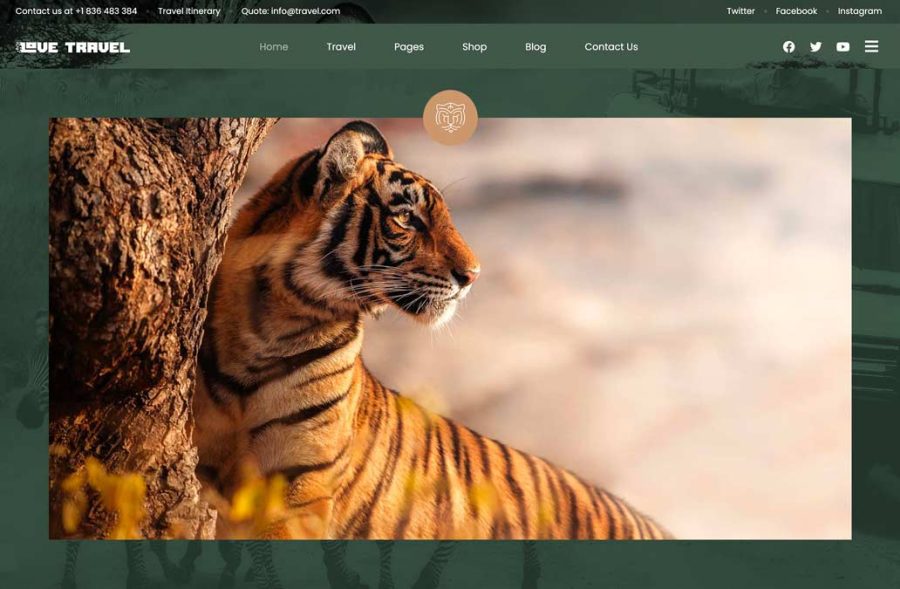In the emerald depths of Tadoba Andhari Tiger Reserve, a legend grew. Maya Tigress Tadoba, also known as T-12, reigned over the landscape with an indomitable presence, becoming one of the most recognized wild tigers of India.Her charisma, coupled with an almost human-like awareness of her audience, made Maya the “Queen of Tadoba,” an enduring symbol of the untamed beauty and fierce maternal instincts of India’s tigers.Over the years, Maya’s life story has been the subject of documentaries, ecotourism discussions, and countless wildlife photographs, her image etched in the hearts of all who had the privilege to encounter her.
The Birth of a Queen: Maya’s Early Life
Born in the Pandharpaoni area in December 2010, Maya’s lineage was rooted in Tadoba’s resilient tiger population.She was the daughter of Leela, a tigress who left behind four cubs when she met an untimely death.For Maya, survival in Tadoba’s dense forests was an early lesson. Left to fend for herself with only the rough wisdom of instinct, she faced the perils of predation and competition head-on, overcoming obstacles that claimed the lives of her siblings.Even as a young cub, Maya stood out, displaying the signs of a spirited tigress who would grow to command her territory.Her rapid adaptation to the jungle’s unforgiving rules revealed an extraordinary mix of intelligence, boldness, and instinct—a combination that marked her as a tiger like no other.Early sightings hinted at Maya’s uncharacteristic ease around humans, as she approached safari jeeps with a natural curiosity and fearlessness that defied the instincts of most wild tigers.
Rising to Stardom: Maya Tigress Tadoba’s Charisma and Hunting Mastery
By the time Maya reached maturity, she had become a star of Tadoba. Her reputation grew as a “people’s tigress,” one who was remarkably tolerant of the safari vehicles that frequented her domain.She was often seen striding through Tadoba’s trails with a confidence that mesmerized visitors.Tigress Maya in Tadoba quickly gained worldwide attention, her image immortalised through thousands of lenses as she approached, often close enough for onlookers to hear the rustle of her footsteps through the underbrush.Her confident nature and magnetic beauty elevated her to the status of Tadoba’s undisputed queenOne of Maya’s defining features was her prowess as a huntress. In a place where survival depends on skill and timing, Maya excelled in both. She often hunted in full view of onlookers, offering an intimate glimpse into the calculated strategies of a tiger in action.The “Maya Tigress Documentary” captured this remarkable skill, showcasing her precision in stalking prey, her ambushes perfectly timed to secure food for her cubs.Her hunting mastery ensured her place not only as a mother of formidable cubs but also as a creature deeply respected in Tadoba’s complex ecosystem.
Maya Tigress Tadoba’s Litters: A Chronicle of Resilience and Loss
Over her decade-long life, Maya, the tigress of Tadoba, raised five litters, producing 13 cubs in total. Her journey as a mother was marked by both success and heartache, with each litter facing unique challenges in Tadoba’s densely populated tiger habitat. Here is an account of her litters, her partners, and the fate of her cubs.
First Litter (2014) – Gabbar’s Cubs
In 2014, Maya’s journey as a mother began when she mated with Gabbar, a powerful male in the area. This pairing produced two cubs, marking Maya’s first attempt at motherhood.Unfortunately, her experience was brief, as these cubs struggled to survive in Tadoba’s competitive environment, possibly due to threats from other males or challenges in food availability.Maya’s loss in this initial litter is believed to have shaped her protective and vigilant approach to rearing future cubs.
Second Litter (2015) – Cubs with Saturn
By 2015, Maya had formed a new bond with another male named Saturn. This partnership proved more successful as Maya gave birth to three cubs. She honed her skills in nurturing and hunting, ensuring that these cubs thrived longer than her first litter.However, the pressures of territorial disputes in Tadoba, where multiple males often overlap with female territories, remained a persistent threat to the young tigers’ survival.Maya’s experience during this litter set the stage for her maternal strategies, balancing affection with an unyielding determination to protect her young.
Third Litter (2017) – Matkasur’s Influence
In 2017, Maya aligned with
Matkasur, a dominant male who was influential in maintaining her territory. This litter of two cubs was a testament to Maya’s strategic prowess.With Matkasur as a protective mate, she focused on nurturing these cubs, and they remained relatively safe under his protection. Maya and Matkasur’s partnership provided the cubs with a more secure environment, allowing Maya to focus on teaching them essential survival skills like stalking and hunting.This period marked a high point in her life as a mother, as her cubs benefited from a stable, guarded territory.
Fourth Litter (2020) – A Period of Turbulence
In 2020, Maya’s life took another significant turn with the birth of her fourth litter, sired by Tala, another male tiger. This time, she bore five cubs, her largest litter to date.Yet, the density of tigers in Tadoba and the rivalry from other males created constant tension. Three of these cubs eventually went missing, believed to have been killed by rival males during incursions into Maya’s territory.Despite the losses, Maya’s remaining cubs displayed resilience, learning quickly from her experienced maternal guidance. Her ability to raise some cubs to independence despite high mortality rates underscored her fierce dedication and adaptability as a mother.
Fifth Litter (2022) – The Final Farewell
Maya’s last litter in 2022, fathered by Balram, highlighted her enduring strength as an older tigress. As she was now a seasoned mother, Maya employed all her hard-earned knowledge to raise this final cub.However, the cub faced a vulnerable existence as Maya began to show signs of aging, impacting her ability to defend her territory.In August 2023, Maya disappeared, and the forest officials discovered skeletal remains later that year, presumed to be hers. Her absence left her last cub without protection, a solemn end to Maya’s incredible life as a prolific mother and guardian of Tadoba’s tiger lineage.
Legacy of Maya’s Lineage in Tadoba
Maya’s litters added to Tadoba’s tiger population, reinforcing genetic diversity and strengthening the reserve’s reputation as a vital tiger habitat.Her efforts as a mother ensured that her lineage would endure, even as her life story became a focal point in conservation efforts and documentaries like
Tiger Queen of Taru.Her journey, filled with moments of maternal bravery and heartbreaking loss, has inspired countless wildlife enthusiasts to appreciate the complex dynamics of tiger life and the critical need for protected habitats.Maya’s life as the beloved “Queen of Tadoba” was a testament to the resilience required to survive as a wild mother in one of India’s most challenging landscapes.Her legacy lives on through her surviving cubs, who roam the same lands she once ruled with grace, tenacity, and a fierce devotion to her young.
Motherhood: The Legacy of a Fierce Protector
Motherhood became Maya’s defining role. Over her lifetime, Maya gave birth to five litters and raised an extraordinary total of 13 cubs, a feat rare among wild tigresses.From her first litter in 2014 to her last in 2022, she nurtured her young with a fierce protectiveness, instilling survival skills and defending them from Tadoba’s competitive male tigers.Her maternal instincts were marked by an intelligence that enabled her to keep cubs alive even in the perilous high-density tiger territory of TadobaWith each litter, Maya’s reputation as a mother of exceptional resilience grew. One notable incident involved her cubs from a 2016 litter who, upon reaching near independence, faced threats from rival males.Maya’s maternal vigilance allowed her cubs to grow in relative safety, despite the challenges posed by Tadoba’s harsh and competitive environment. In this respect, Maya’s success mirrored the legendary tigresses of other reserves, such as Ranthambore’s Machli and Pench’s Collarwali
The Tragic Encounter: Maya and the Death of a Forest Guard
In 2017, a tragic incident underscored the unpredictability of life in the wild. Maya, fiercely protective of her cubs, encountered a women forest guard who had unknowingly ventured too close to her
during a survey.In a swift, defensive reaction, she attacked, leading to her death. This encounter opened discussions about the delicate balance required to coexist with such powerful creatures.It highlighted the complexities of Maya’s world, where her instincts as a mother and protector at times conflicted with the very human efforts to admire her up close.
The Disappearance and Speculation: Mystery Surrounding Maya Tigress Death
By August 2023, Maya, the “Enchantress of Tadoba,” had seemingly vanished. Her usual sightings near Tadoba Lake ceased, and the forest’s quiet was now a reminder of her absence.The forest department launched a sweeping search across her territory, combing the
core areas and buffer zones for any trace of her, but the efforts were in vain.Finally, in November 2023, skeletal remains were discovered in a remote part of Tadoba’s dense forest.Though unconfirmed at the time, the remains are believed to be Maya’s. Samples were sent to the National Centre for Biological Sciences for
DNA analysis to confirm her identity, leaving Tadoba’s staff and her countless admirers waiting with bated breath.The uncertainty around her fate adds a tragic note to Maya’s legacy—a life that blazed like a fire through the forest, now reduced to quiet speculation
Maya the tigress: Impact on Conservation and Ecotourism
Throughout her life, Maya wasn’t just a tigress; she was an ambassador for Tadoba, bringing the world’s attention to India’s tiger conservation efforts.Tigress Maya’s popularity fueled a surge in ecotourism for Tadoba, bringing in funds that were funnelled back into conservation, protecting habitats, and supporting anti-poaching efforts.Her presence provided an economic boost, drawing tourists from across the globe, each visit a small part of the funding that sustained Tadoba’s wildlife protection programs.But Maya’s legacy is perhaps most visible in the way she bridged the world of humans and the wild.Through countless photographs, documentaries, and firsthand accounts, Maya Tigress Tadoba became a figure of wonder, an invitation for people to reflect on the beauty and fragility of wilderness.She demonstrated the need for spaces where tigers and other creatures could exist unthreatened by human encroachment
The Queen Lives On: Maya’s Enduring Legacy
Even as Tadoba’s forests grow silent in her absence, the legend of Maya continues to inspire. Her life is a testament to resilience, to the fierce beauty of motherhood, and to the intricate ways in which nature and humanity intersect.Like the great tigresses who came before her—Machli of Ranthambore, Collarwali of Pench—Maya’s story will continue to be told as a symbol of the wild’s enduring mysteries.Her paw prints remain on the trails of Tadoba, and her spirit lives on in the whispers of the forest, a timeless reminder of the untamed beauty and fragile existence of India’s tiger population.As we await the results of the DNA test that will confirm her fate, Tigress Maya Tadoba’s story is an invitation to protect the sanctuaries and reserves that serve as the last bastions for these extraordinary creatures.Her life and legacy are a call to action for all who value the natural world, urging us to protect the habitats that allow Maya and her kind to roam freely, majestic and unbound.

























